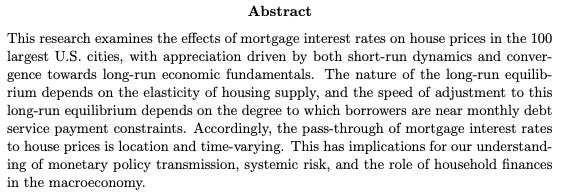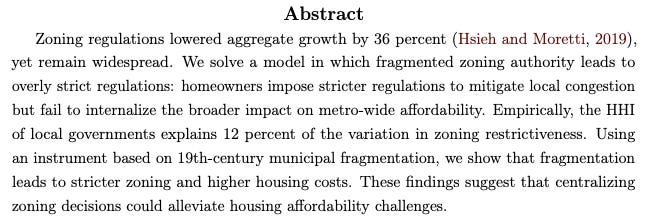Weekly Roundup #9
Housing | Mortgages, housing demographics, family formation, and more
EXECUTIVE SUMMARY
Welcome back to the Boyd Institute’s roundup series. This week we had a substantive conversation with economist and realist Mike Fellman, during which we discussed the state of housing mostly through the lens of capital markets. “Housing is just inequality — always has been, always will be,” he says. Watch the full convo here:
Then on Thursday we published an all-things-considered, comprehensive proposal for how a conservatorship exit for Fannie Mae and Freddie Mac should be pulled off. We recommend a hybrid approach, not a pure-play IPO. But alas, by the looks of it, the current administration seems hell bent on making the NYSE bell ring. We nevertheless submitted our plan to the FHFA in the off chance it doesn’t fall on deaf ears. One can hope!
As for this week’s roundup, the topics and themes are pretty wide-ranging — demographics and fertility, mortgage markets, supply-side research, you name it.
Newsflow:
The median age for first-time homebuyers in the US has risen rapidly, eclipsing 40 for the first time on record.
Adjustable-rate mortgages rose to 10% of purchase-mortgage applications for the first week of October, the most since 2023.
Three key YIMBY/affordable housing proposals were approved by New York City voters on Tuesday night.
Academic research:
On how the pass-through effects from mortgage rates to home prices is highly location- and time-varying.
On how suburbs tend to protect their little fiefdoms without accounting for the damage it causes to the broader regional housing market.
Additional reading:
On how the cost of housing is one big barrier to family formation, but simply building more single family homes isn’t the answer.
COMMUNITY POLL
In light of our proposal to the FHFA this week, we’re asking readers about what they think the current administration should do with Fannie Mae and Freddie Mac, the GSEs who guarantee then securitize trillions in US mortgages each year, both of which have sat in conservatorship since 2008.
NEWSFLOW
Bloomberg: The median age for first-time homebuyers in the US now sits at a record of 40, up from 33 just a few years ago, as soaring prices and mortgage rates over the last few years delay homeownership for millions of Americans.
The NAR warned that the loss of a decade of homeownership could cost Americans roughly $150,000 in equity on a typical starter home. The median price of an existing home currently stands at $415,200 — up more than 50% since 2019. At the same time, mortgage rates are roughly twice as high as they were in late 2021.
Over the past year, first-time buyers accounted for 21% of the market, the lowest since the NAR began collecting such data in 1981 and about half the pre-2008 norm.
Bloomberg: Three proposals involving NYC housing — fast-tracking affordable housing projects (2), expediting modest developments (3), and creating an appeals board (4) — were approved by voters.
Proposal 2 allows affordable housing developments to bypass City Council for both publicly-financed projects and projects in the 12 community districts with the lowest rates of affordable housing, which tend to be wealthier and whiter.
Proposal 3 creates an Expedited Land Use Review Procedure, or ELURP, for smaller proposals. The new process combines community board and borough president reviews into 60 days, followed by a 30-day City Planning Commission review.
Proposal 4 establishes an “Affordable Housing Appeals Board” made up of the mayor, the City Council speaker and the relevant borough president. The board can overturn land-use decisions approved or rejected by the council.
“Just 10 of New York City’s 51 Council districts have built more than half of all affordable housing since 2014.”
WSJ: Adjustable-rate mortgages (ARMs) accounted for 10% of purchase-mortgage applications in the week ended 10/3, the highest since 2023, as buyers are betting that mortgage rates will fall in the coming years. Buyers are desperate for affordable monthly payments when home prices are up more than 50% since 2019 and are near all-time highs. (ARMs have lower upfront rates than fixed loans.)
Home-insurance and property-tax costs have also climbed in many parts of the country. They are also getting a boost from home builders. Builders said on average that 14% of their buyers in the past month had used ARMs, according to an October survey by John Burns — large builders D.R. Horton and Century Communities also have noted an increase in ARM usage in recent earnings calls.
ACADEMIC RESEARCH
Effects of Mortgage Interest Rates on House Price Appreciation: The Role of Payment Constraints
Larson (2022)
The findings of Larson (2022) are fascinating and highly relevant to the current housing environment. It finds, importantly, that the pass-through effects from mortgage rates to home prices is highly location- and time-varying. “In markets where people are already at their payment limit, interest-rate changes bind immediately.”
For example, it finds that in Phoenix, Austin, and Atlanta, where supply is elastic and borrowers are stretched, price growth decisively reacts when rates move. This is contrasted by its findings that in the Bay Area, NYC, Boston, and Boulder, where supply is inelastic and there are larger portions of cash/equity buyers, prices are more insulated from mortgage rate movements.
The big picture, and a departure from some conventional thinking is that the causality is reversed in many high-cost metros: it’s not that rates drive prices, it’s that zoning/supply scarcity drives buyer composition, which then blunt rate sensitivity. Thus, in places like the Bay Area, rate hikes don’t cool prices — they change who buys, not whether someone buys. Furthermore:
Monetary policy (e.g., Fed Funds Rate adjustments; quantitative easing/tapering through the MBS channel, etc.) has geographically uneven effects.
Thus, the Fed cannot effectively cool housing prices in markets where zoning throttles supply.
Thus, local housing policy trumps monetary policy with respect to affordability.
Thus, national-level house price indices are misleading for policy design.
This does lend credence to the YIMBY view that local housing supply constraints drive down affordability, yet you rarely (if ever) hear YIMBYs use this line of reasoning.
Why zoning is too restrictive
Favilukis and Song (2025)
This study’s findings are both elegant and damning for the “local control” paradigm in US zoning. They build a model showing that when zoning authority is fragmented across many small municipalities — each dominated by incumbent homeowners — those homeowners internalize the local benefits of restrictive zoning (less congestion, higher neighborhood amenity value) while externalizing the regional costs (higher metro-wide housing prices, slower population growth, lower economic output). Basically each suburb protects its little fiefdom without accounting for the damage it causes to the broader regional housing market.
This debate traces back to Hsieh & Moretti (2019) — the study claiming restrictive zoning reduced US growth by 36% — which has been a staple in the pro-YIMBY worldview, yet its credibility has been eroding. Cameron Murray and others have shown in replications that the original H&M calibration overstated the macro effect, contained coding mistakes, and — when corrected — shrinks the effect dramatically (36% slower growth → ~14% GDP gap → near-zero in replication).
Be that as it may, what makes Favilukis and Song (2025) compelling is that they don’t rely on H&M’s macro calibration at all. They show instead that:
The political structure of zoning matters as much as zoning itself.
More fragmented metros produce more restrictive rules because each small jurisdiction is captured by homeowners with anti-growth incentives.
Zoning is a negative externality.
Homeowners benefit locally, but non-residents bear the regional cost through higher prices and reduced in-migration.
Fixing zoning means fixing the governance layer.
Implies that moving zoning authority up from municipal → metro → state level internalizes the externality.
The big conceptual break here from older, catch-all, “supply-constraints reduce growth” tropes is that the true policy lever isn’t just deregulation, it’s about jurisdictional redesign and who gets to write the regulation. Ultimately, this study suggests that the governance structure itself shapes elasticity — and metro-wide or state-level governance reform could alleviate affordability by removing homeowner capture.
ADDITIONAL READING
To Support Families, Repair the Housing Ladder
Governing | Emily Hamilton
A falling population will mean challenges for entitlement programs and for meeting the needs of a growing number of retired people dependent on a smaller working-age population. There are several explanations for this decline in birth rate. One underappreciated reason is high housing costs and a shortage of affordable options in the places people want to live. Many demographic studies find that reduced housing affordability — particularly when it comes to owning the home you live in — goes hand in hand with starting families later in life and having fewer total children. With that in mind, it would be easy to assume that we now need a package of family-specific housing policies, such as more single-family zoning (“family” is right there in the name!). But in fact, those policies have been in place for generations, and they’re failing.
[…]
Single-family zoning severely limits the areas where more cost-effective multifamily housing can be built. Research shows that fertility is lower in tightly regulated housing markets than in more flexible ones. The least-expensive homes — single-room occupancy units with shared kitchens — have been all but eliminated. The amount of land where manufactured housing can be sited is shrinking precipitously. The availability of apartments — including family-friendly ones — townhomes, and other starter homes is also affected. The morass of rules driving construction toward more expensive types of housing has fueled a mismatch between types of households and the housing stock.
[…]
Architectural determinism is poor family policy. You can’t legislate babies by legislating big houses. But you can give people the freedom to climb the housing ladder one rung at a time, starting families along the way. Relaxing all types of land use regulations — those that are standing in the way of more single-family houses and, perhaps even more importantly, those that are standing in the way of less-expensive options — is the path toward improved affordability and more family formation.









"On how suburbs tend to protect their little fiefdoms without accounting for the damage it causes to the broader regional housing market."
I'm not a personal observer of any suburban markes but in the urban ones, I have the impression that NIMBYs often just realy do not see the the benefits to the users of the new assets and local taxpayers they are blocking. So tis kindo of research is importat or both NIMBYs ad YIMBYs